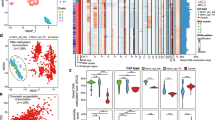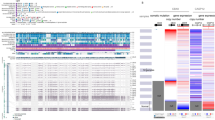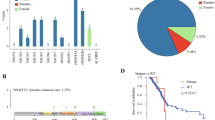Abstract
Pancreatic cancer is among the top five deadliest cancers in developed countries. Better knowledge of the molecular mechanisms contributing to its tumorigenesis is imperative to improve patient prognosis. Identification of novel tumor suppressor genes (TSGs) in pancreatic cancer will reveal new mechanisms of pathway deregulation and will ultimately help improve our understanding of this aggressive disease. According to Knudson’s two-hit model, TSGs are classically disrupted by two concerted genetic events. In this study, we combined DNA methylation profiling with copy number and mRNA expression profiling to identify novel TSGs in a set of 20 pancreatic cancer cell lines. These data sets were integrated for each of ∼12 000 genes in each cell line enabling the elucidation of those genes that undergo DNA hypermethylation, copy-number loss and mRNA downregulation simultaneously in multiple cell lines. Using this integrative genomics strategy, we identified SOX15 (sex determining region Y—box 15) as a candidate TSG in pancreatic cancer. Expression of SOX15 in pancreatic cancer cell lines with undetectable expression resulted in reduced viability of cancer cells both in vitro and in vivo demonstrating its tumor suppressive capability. We also found reduced expression, homozygous deletion and aberrant DNA methylation of SOX15 in clinical pancreatic tumor data sets. Furthermore, we deduced a novel role for SOX15 in suppressing the Wnt/β-catenin signaling pathway, which we hypothesize is a pathway through which SOX15 may exert its tumor suppressive effects in pancreatic cancer.
This is a preview of subscription content, access via your institution
Access options
Subscribe to this journal
Receive 50 print issues and online access
$259.00 per year
only $5.18 per issue
Buy this article
- Purchase on Springer Link
- Instant access to full article PDF
Prices may be subject to local taxes which are calculated during checkout




Similar content being viewed by others
References
Jemal A, Bray F, Center MM, Ferlay J, Ward E, Forman D . Global cancer statistics. CA Cancer J Clin 2011; 61: 69–90.
Bardeesy N, DePinho RA . Pancreatic cancer biology and genetics. Nat Rev Cancer 2002; 2: 897–909.
Hezel AF, Kimmelman AC, Stanger BZ, Bardeesy N, Depinho RA . Genetics and biology of pancreatic ductal adenocarcinoma. Genes Dev 2006; 20: 1218–1249.
Singh P, Srinivasan R, Wig JD . Major molecular markers in pancreatic ductal adenocarcinoma and their roles in screening, diagnosis, prognosis, and treatment. Pancreas 2011; 40: 644–652.
Samuel N, Hudson TJ . The molecular and cellular heterogeneity of pancreatic ductal adenocarcinoma. Nat Rev Gastroenterol Hepatol 2012; 9: 77–87.
Jones S, Zhang X, Parsons DW, Lin JC, Leary RJ, Angenendt P et al. Core signaling pathways in human pancreatic cancers revealed by global genomic analyses. Science 2008; 321: 1801–1806.
Mann KM, Ward JM, Yew CC, Kovochich A, Dawson DW, Black MA et al. Sleeping Beauty mutagenesis reveals cooperating mutations and pathways in pancreatic adenocarcinoma. Proceedings of the National Academy of Sciences of the United States of America 2012; 109: 5934–5941.
Jiao Y, Shi C, Edil BH, de Wilde RF, Klimstra DS, Maitra A et al. DAXX/ATRX, MEN1, and mTOR pathway genes are frequently altered in pancreatic neuroendocrine tumors. Science 2011; 331: 1199–1203.
Wu J, Jiao Y, Dal Molin M, Maitra A, de Wilde RF, Wood LD et al. Whole-exome sequencing of neoplastic cysts of the pancreas reveals recurrent mutations in components of ubiquitin-dependent pathways. Proceedings of the National Academy of Sciences of the United States of America 2011; 108: 21188–21193.
Birnbaum DJ, Adelaide J, Mamessier E, Finetti P, Lagarde A, Monges G et al. Genome profiling of pancreatic adenocarcinoma. Genes Chromosomes Cancer 2011; 50: 456–465.
Joergensen MT, Geisz A, Brusgaard K, Schaffalitzky de Muckadell OB, Hegyi P, Gerdes AM et al. Intragenic duplication: a novel mutational mechanism in hereditary pancreatitis. Pancreas 2011; 40: 540–546.
Yachida S, Jones S, Bozic I, Antal T, Leary R, Fu B et al. Distant metastasis occurs late during the genetic evolution of pancreatic cancer. Nature 2010; 467: 1114–1117.
Berger AH, Knudson AG, Pandolfi PP . A continuum model for tumour suppression. Nature 2011; 476: 163–169.
Bernard P, Harley VR . Acquisition of SOX transcription factor specificity through protein-protein interaction, modulation of Wnt signalling and post-translational modification. Int J Biochem Cell Biol 2010; 42: 400–410.
Tan AC, Jimeno A, Lin SH, Wheelhouse J, Chan F, Solomon A et al. Characterizing DNA methylation patterns in pancreatic cancer genome. Mol Oncol 2009; 3: 425–438.
Vincent A, Omura N, Hong SM, Jaffe A, Eshleman J, Goggins M . Genome-wide analysis of promoter methylation associated with gene expression profile in pancreatic adenocarcinoma. Clinic Cancer Res 2011; 17: 4341–4354.
Hong SM, Omura N, Vincent A, Li A, Knight S, Yu J et al. Genome-wide CpG island profiling of intraductal papillary mucinous neoplasms of the pancreas. Clinic Cancer Res 2012; 18: 700–712.
Du YC, Oshima H, Oguma K, Kitamura T, Itadani H, Fujimura T et al. Induction and down-regulation of Sox17 and its possible roles during the course of gastrointestinal tumorigenesis. Gastroenterology 2009; 137: 1346–1357.
Zhang W, Glockner SC, Guo M, Machida EO, Wang DH, Easwaran H et al. Epigenetic inactivation of the canonical Wnt antagonist SRY-box containing gene 17 in colorectal cancer. Cancer Res 2008; 68: 2764–2772.
Jia Y, Yang Y, Liu S, Herman JG, Lu F, Guo M . SOX17 antagonizes WNT/beta-catenin signaling pathway in hepatocellular carcinoma. Epigenetics 2010; 5: 743–749.
Sakai M, Hibi K, Koshikawa K, Inoue S, Takeda S, Kaneko T et al. Frequent promoter methylation and gene silencing of CDH13 in pancreatic cancer. Cancer Sci 2004; 95: 588–591.
Andreeva AV, Kutuzov MA . Cadherin 13 in cancer. Genes Chromosomes Cancer 2010; 49: 775–790.
Bachman KE, Herman JG, Corn PG, Merlo A, Costello JF, Cavenee WK et al. Methylation-associated silencing of the tissue inhibitor of metalloproteinase-3 gene suggest a suppressor role in kidney, brain, and other human cancers. Cancer Res 1999; 59: 798–802.
MacGrogan D, Levy A, Bova GS, Isaacs WB, Bookstein R . Structure and methylation-associated silencing of a gene within a homozygously deleted region of human chromosome band 8p22. Genomics 1996; 35: 55–65.
McCleary-Wheeler AL, McWilliams R, Fernandez-Zapico ME . Aberrant signaling pathways in pancreatic cancer: a two compartment view. Mol Carcinog 2012; 51: 25–39.
Morris JPt, Wang SC, Hebrok M . KRAS, Hedgehog, Wnt and the twisted developmental biology of pancreatic ductal adenocarcinoma. Nat Rev Cancer 2010; 10: 683–695.
Pasca di Magliano M, Biankin AV, Heiser PW, Cano DA, Gutierrez PJ, Deramaudt T et al. Common activation of canonical Wnt signaling in pancreatic adenocarcinoma. PloS one 2007; 2: e1155.
Suzuki H, Watkins DN, Jair KW, Schuebel KE, Markowitz SD, Chen WD et al. Epigenetic inactivation of SFRP genes allows constitutive WNT signaling in colorectal cancer. Nat Genet 2004; 36: 417–422.
Suzuki H, Toyota M, Carraway H, Gabrielson E, Ohmura T, Fujikane T et al. Frequent epigenetic inactivation of Wnt antagonist genes in breast cancer. Br J Cancer 2008; 98: 1147–1156.
Kongkham PN, Northcott PA, Croul SE, Smith CA, Taylor MD, Rutka JT . The SFRP family of WNT inhibitors function as novel tumor suppressor genes epigenetically silenced in medulloblastoma. Oncogene 2010; 29: 3017–3024.
Licchesi JD, Westra WH, Hooker CM, Machida EO, Baylin SB, Herman JG . Epigenetic alteration of Wnt pathway antagonists in progressive glandular neoplasia of the lung. Carcinogenesis 2008; 29: 895–904.
Gumz ML, Zou H, Kreinest PA, Childs AC, Belmonte LS, LeGrand SN et al. Secreted frizzled-related protein 1 loss contributes to tumor phenotype of clear cell renal cell carcinoma. Clin Cancer Res 2007; 13: 4740–4749.
Rajan N, Burn J, Langtry J, Sieber-Blum M, Lord CJ, Ashworth A . Transition from cylindroma to spiradenoma in CYLD-defective tumours is associated with reduced DKK2 expression. J Pathol 2011; 224: 309–321.
Sato H, Suzuki H, Toyota M, Nojima M, Maruyama R, Sasaki S et al. Frequent epigenetic inactivation of DICKKOPF family genes in human gastrointestinal tumors. Carcinogenesis 2007; 28: 2459–2466.
Tennis MA, Vanscoyk M, Freeman S, Winn RA . Promoter hypermethylation leads to loss of wnt7a in non-small cell lung cancer. Proceedings of the American Thoracic Society 2012; 9: 83–84.
Tennis MA, Vanscoyk MM, Wilson LA, Kelley N, Winn RA . Methylation of Wnt7a is modulated by dnmt1 and cigarette smoke condensate in non-small cell lung cancer. PloS one 2012; 7: e32921.
Rubin JS, Barshishat-Kupper M, Feroze-Merzoug F, Xi ZF . Secreted WNT antagonists as tumor suppressors: pro and con. Front Biosci 2006; 11: 2093–2105.
Qin YR, Tang H, Xie F, Liu H, Zhu Y, Ai J et al. Characterization of tumor-suppressive function of SOX6 in human esophageal squamous cell carcinoma. Clinic Cancer Res 2011; 17: 46–55.
Ye YW, Wu JH, Wang CM, Zhou Y, Du CY, Zheng BQ et al. Sox17 regulates proliferation and cell cycle during gastric cancer progression. Cancer Lett 2011; 307: 124–131.
Kormish JD, Sinner D, Zorn AM . Interactions between SOX factors and Wnt/beta-catenin signaling in development and disease. Dev Dyn 2010; 239: 56–68.
van Noort M, Meeldijk J, van der Zee R, Destree O, Clevers H . Wnt signaling controls the phosphorylation status of beta-catenin. J Biol Chem 2002; 277: 17901–17905.
Lochhead PA, Gilley R, Cook SJ . ERK5 and its role in tumour development. Biochem Soc Trans 2012; 40: 251–256.
Drew BA, Burow ME, Beckman BS . MEK5/ERK5 pathway: the first fifteen years. Biochim Biophys Acta 2012; 1825: 37–48.
Medina PP, Castillo SD, Blanco S, Sanz-Garcia M, Largo C, Alvarez S et al. The SRY-HMG box gene, SOX4, is a target of gene amplification at chromosome 6p in lung cancer. Hum Mol Genet 2009; 18: 1343–1352.
Liu P, Ramachandran S, Ali Seyed M, Scharer CD, Laycock N, Dalton WB et al. Sex-determining region Y box 4 is a transforming oncogene in human prostate cancer cells. Cancer Res 2006; 66: 4011–4019.
Bass AJ, Watanabe H, Mermel CH, Yu S, Perner S, Verhaak RG et al. SOX2 is an amplified lineage-survival oncogene in lung and esophageal squamous cell carcinomas. Nat Genet 2009; 41: 1238–1242.
Gustavsson E, Sernbo S, Andersson E, Brennan DJ, Dictor M, Jerkeman M et al. SOX11 expression correlates to promoter methylation and regulates tumor growth in hematopoietic malignancies. Mol Cancer 2010; 9: 187.
Forbes SA, Bindal N, Bamford S, Cole C, Kok CY, Beare D et al. COSMIC: mining complete cancer genomes in the catalogue of somatic mutations in cancer. Nucleic Acids Res 2011; 39: Database issue D945–D950.
Harada T, Chelala C, Bhakta V, Chaplin T, Caulee K, Baril P et al. Genome-wide DNA copy number analysis in pancreatic cancer using high-density single nucleotide polymorphism arrays. Oncogene 2008; 27: 1951–1960.
Cerami E, Gao J, Dogrusoz U, Gross BE, Sumer SO, Aksoy BA et al. The cBio cancer genomics portal: an open platform for exploring multidimensional cancer genomics data. Cancer discov 2012; 2: 401–404.
Yan HT, Shinka T, Sato Y, Yang XJ, Chen G, Sakamoto K et al. Overexpression of SOX15 inhibits proliferation of NT2/D1 cells derived from a testicular embryonal cell carcinoma. Mol Cells 2007; 24: 323–328.
Beranger F, Mejean C, Moniot B, Berta P, Vandromme M . Muscle differentiation is antagonized by SOX15, a new member of the SOX protein family. J Biol Chem 2000; 275: 16103–16109.
Lee HJ, Goring W, Ochs M, Muhlfeld C, Steding G, Paprotta I et al. Sox15 is required for skeletal muscle regeneration. Mol Cell Biol 2004; 24: 8428–8436.
Meeson AP, Shi X, Alexander MS, Williams RS, Allen RE, Jiang N et al. Sox15 and Fhl3 transcriptionally coactivate Foxk1 and regulate myogenic progenitor cells. EMBO J 2007; 26: 1902–1912.
Savage J, Conley AJ, Blais A, Skerjanc IS . SOX15 and SOX7 differentially regulate the myogenic program in P19 cells. Stem Cells 2009; 27: 1231–1243.
Ito M . Function and molecular evolution of mammalian Sox15, a singleton in the SoxG group of transcription factors. Int J Biochem Cell Biol 2010; 42: 449–452.
White BD, Chien AJ, Dawson DW . Dysregulation of Wnt/beta-catenin signaling in gastrointestinal cancers. Gastroenterology 2012; 142: 219–232.
Yao H, Ashihara E, Maekawa T . Targeting the Wnt/beta-catenin signaling pathway in human cancers. Expert Opin Ther Targets 2011; 15: 873–887.
Polakis P . Drugging Wnt signalling in cancer. EMBO J 2012; 31: 2737–2746.
Klarmann GJ, Decker A, Farrar WL . Epigenetic gene silencing in the Wnt pathway in breast cancer. Epigenetics 2008; 3: 59–63.
Dihlmann S, von Knebel Doeberitz M . Wnt/beta-catenin-pathway as a molecular target for future anti-cancer therapeutics. Int J Cancer 2005; 113: 515–524.
Moon RT, Kohn AD, De Ferrari GV, Kaykas A . WNT and beta-catenin signalling: diseases and therapies. Nat Rev Genet 2004; 5: 691–701.
Bibikova M, Lin Z, Zhou L, Chudin E, Garcia EW, Wu B et al. High-throughput DNA methylation profiling using universal bead arrays. Genome Res 2006; 16: 383–393.
Ishkanian AS, Malloff CA, Watson SK, DeLeeuw RJ, Chi B, Coe BP et al. A tiling resolution DNA microarray with complete coverage of the human genome. Nat Genet 2004; 36: 299–303.
Khojasteh M, Lam WL, Ward RK, MacAulay C . A stepwise framework for the normalization of array CGH data. BMC bioinformatics 2005; 6: 274.
Coe BP, Chari R, MacAulay C, Lam WL . FACADE: a fast and sensitive algorithm for the segmentation and calling of high resolution array CGH data. Nucleic Acids Res 2010; 38: e157.
Simon R, Lam A, Li MC, Ngan M, Menenzes S, Zhao Y . Analysis of gene expression data using BRB-ArrayTools. Cancer Inform 2007; 3: 11–17.
Mak AB, Ni Z, Hewel JA, Chen GI, Zhong G, Karamboulas K et al. A lentiviral functional proteomics approach identifies chromatin remodeling complexes important for the induction of pluripotency. Mol Cel Proteomics 2010; 9: 811–823.
Dull T, Zufferey R, Kelly M, Mandel RJ, Nguyen M, Trono D et al. A third-generation lentivirus vector with a conditional packaging system. J Virol 1998; 72: 8463–8471.
Thu KL, Pikor LA, Chari R, Wilson IM, Macaulay CE, English JC et al. Genetic disruption of KEAP1/CUL3 E3 ubiquitin ligase complex components is a key mechanism of NF-kappaB pathway activation in lung cancer. J Thorac Oncol 2011; 6: 1521–1529.
Lockwood WW, Thu KL, Lin L, Pikor LA, Chari R, Lam WL et al. Integrative genomics identified RFC3 as an amplified candidate oncogene in esophageal adenocarcinoma. Clin Cancer Res 2012; 18: 1936–1946.
Radulovich N, Qian JY, Tsao MS . Human pancreatic duct epithelial cell model for KRAS transformation. Methods Enzymol 2008; 439: 1–13.
Acknowledgements
KLT, NR and LAP are supported by Vanier Canada Graduate Scholarships, DDBS by University of British Columbia 4YF scholarship and WWL by a CIHR Jean-Francois Saint Denis Fellowship in Cancer Research. This work was supported by grants from the Canadian Cancer Society Research Institute (#700809), the Canadian Institutes for Health Research, PMH Foundation and Ontario Ministry of Health and Long Term Care. MST is the M Qasim Choksi Chair in Lung Cancer Translational Research.
Author information
Authors and Affiliations
Corresponding authors
Ethics declarations
Competing interests
The authors declare no conflict of interest.
Additional information
Supplementary Information accompanies the paper on the Oncogene website
Supplementary information
Rights and permissions
About this article
Cite this article
Thu, K., Radulovich, N., Becker-Santos, D. et al. SOX15 is a candidate tumor suppressor in pancreatic cancer with a potential role in Wnt/β-catenin signaling. Oncogene 33, 279–288 (2014). https://doi.org/10.1038/onc.2012.595
Received:
Revised:
Accepted:
Published:
Issue Date:
DOI: https://doi.org/10.1038/onc.2012.595
Keywords
This article is cited by
-
Epigenetic priming targets tumor heterogeneity to shift transcriptomic phenotype of pancreatic ductal adenocarcinoma towards a Vitamin D susceptible state
Cell Death & Disease (2024)
-
Effective anticancer agents based-on two Pillar[5]arene derivatives for pancreas cancer cell lines: synthesis, apoptotic effect, caspase pathway
Investigational New Drugs (2023)
-
SOX15 transcriptionally increases the function of AOC1 to modulate ferroptosis and progression in prostate cancer
Cell Death & Disease (2022)
-
SOX13 promotes colorectal cancer metastasis by transactivating SNAI2 and c-MET
Oncogene (2020)
-
Up-regulation of microRNA-200c-3p inhibits invasion and migration of renal cell carcinoma cells via the SOX2-dependent Wnt/β-catenin signaling pathway
Cancer Cell International (2019)



